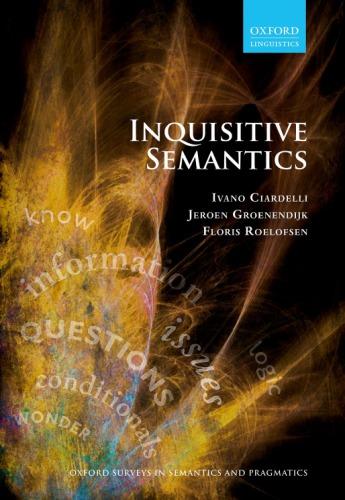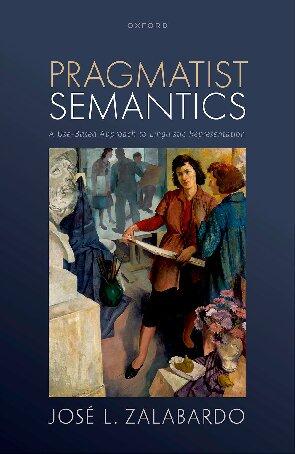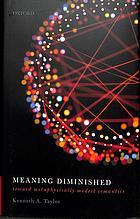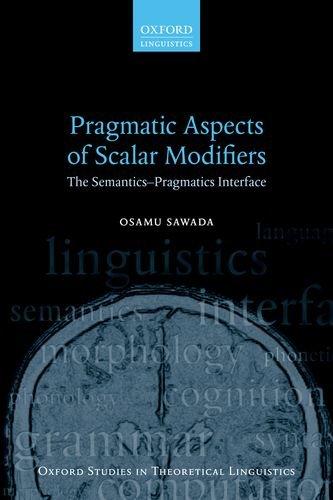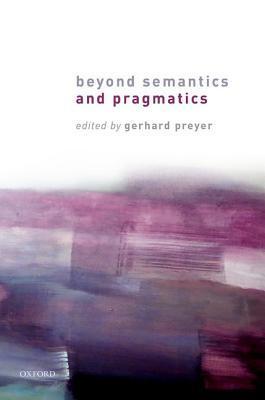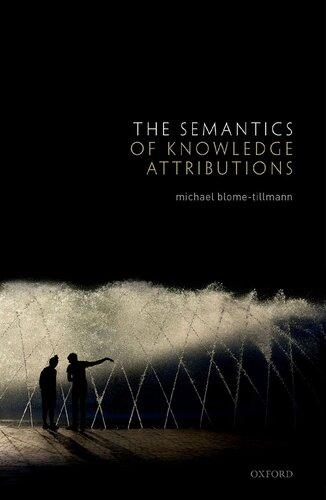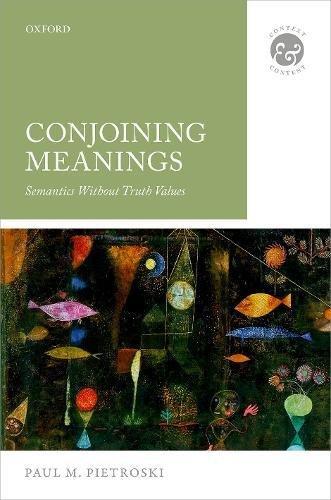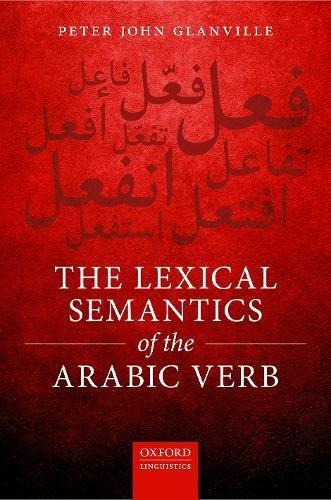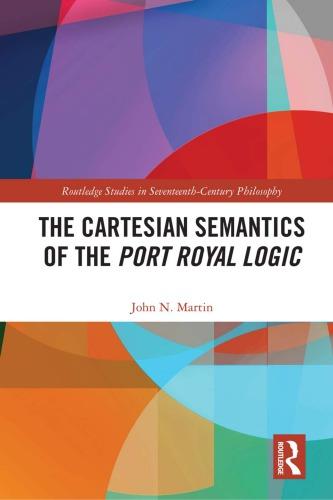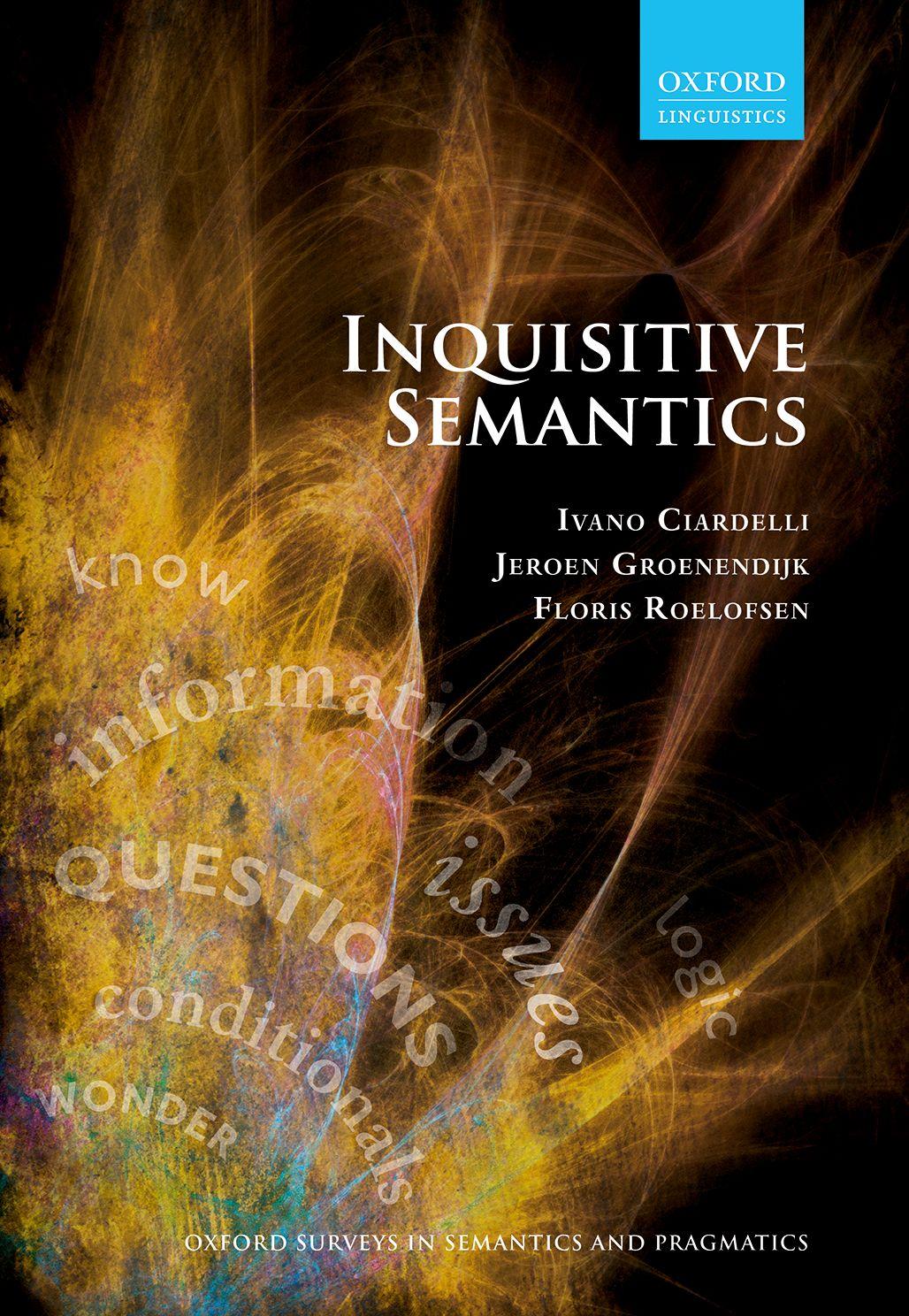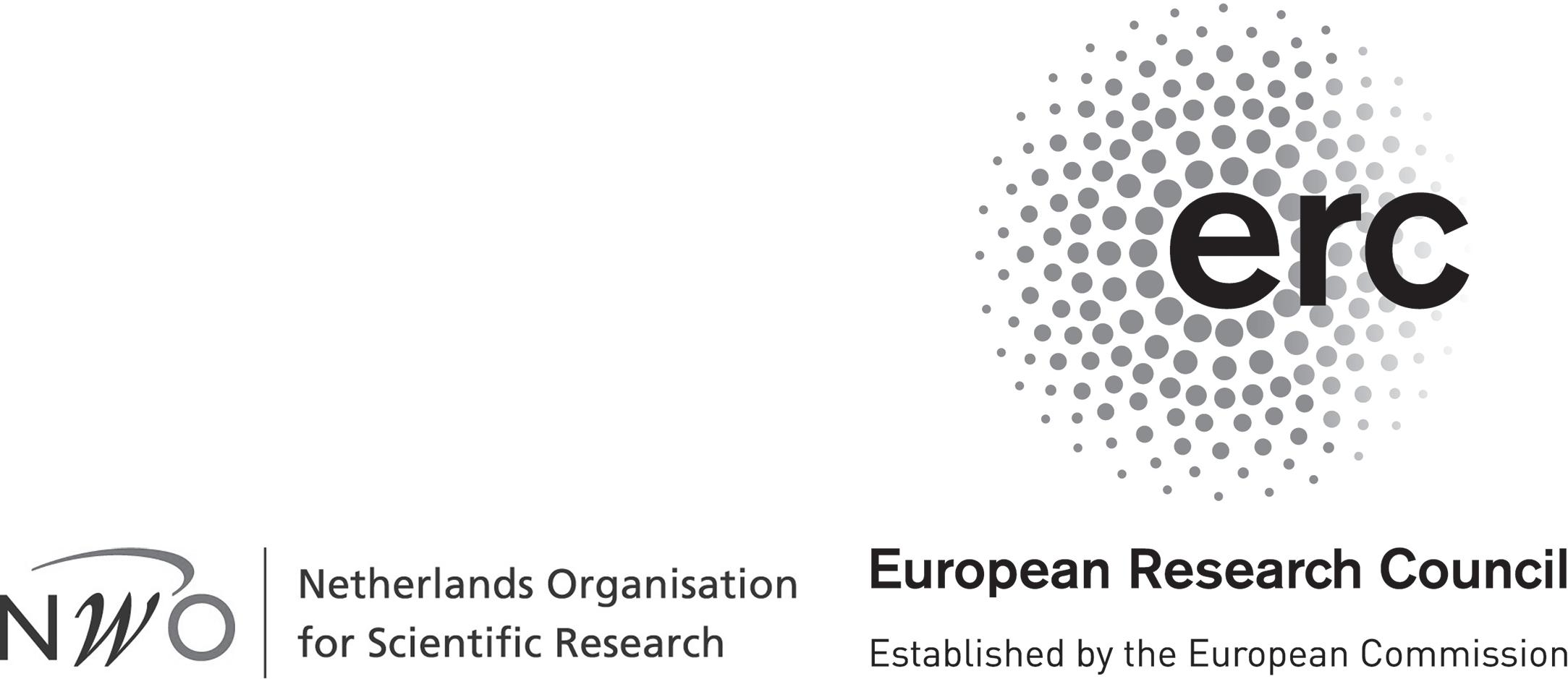1 Introduction
Inquisitivesemanticsisanewsemanticframeworkmainlyintendedfor theanalysisoflinguisticinformationexchange.Informationexchange canbeseenasaprocessofraisingandresolvingissues.Inquisitive semanticsprovidesanewformalnotionofissues,whichmakesit possibletomodelvariousconceptsthatarecrucialfortheanalysisof linguisticinformationexchangeinamorerefinedandmoreprincipled waythanhasbeenpossibleinpreviousframeworks.Inparticular:
.The semanticcontent ofbothdeclarativeandinterrogativesentencescanberepresentedinanintegratedway,capturingnotonly theinformationthatsuchsentencesconvey,butalsotheissuesthat theyraise;
.Similarly, conversationalcontexts canbemodeledasencompassingnotjusttheinformationthathasbeenestablishedinthe conversationsofar,butalsotheissuesthathavebeenbroughtup;
.Andfinally,itbecomespossibletoformallyrepresentabroader rangeof propositionalattitudes thatarerelevantforinformation exchange:besidesthefamiliarinformation-directedattitudeslike knowing and believing,issue-directedattitudeslike wondering can becapturedaswell.
Thisbookprovidesadetailedexpositionofthemostbasicfeaturesof inquisitivesemantics,anddemonstratessomeoftheadvantagesthatthe frameworkhaswithrespecttopreviouslyproposedwaysofrepresenting semanticcontent,conversationalcontexts,andpropositionalattitudes.
Thisintroductorychapterwillproceedtoargueinsomedetailwhya frameworklikeinquisitivesemanticsisneededforasatisfactoryanalysis ofinformationexchange(Section.),andwillendwithaglobaloutline oftheremainingchapters(Section.).
InquisitiveSemantics.Firstedition.IvanoCiardelli,JeroenGroenendijk,andFlorisRoelofsen. ©IvanoCiardelli,JeroenGroenendijk,andFlorisRoelofsen.FirstpublishedbyOxford UniversityPress.
1.1Motivation
Themostbasicquestionthatneedstobeaddressedinmoredetail beforeweintroducethenewformalnotionofissuesthatformsthe cornerstoneofinquisitivesemanticsiswhysuchanotionisneededat allfortheanalysisoflinguisticinformationexchange.Thiswillbedone inSection...
Asecondfundamentalpointthatwewanttomakeisthattheanalysis oflinguisticinformationexchangedoesnotjustrequireasemantictheoryofdeclarativesandanothersemantictheoryofinterrogativessideby side,butratheran integrated theoryofdeclarativesandinterrogatives; neithersentencetypecanbefullyunderstoodinisolation.Reasonsfor thiswillbegiveninSection...
Finally,athirdimportantpointisthatasemantictheoryofdeclarativesandinterrogativesshouldnotemploytwodifferentnotionsof semanticcontent,onefordeclarativesandoneforinterrogatives,but shouldratherbebasedonasinglenotionofsemanticcontentthatis generalenoughtocaptureboththeinformationthatsentencesconvey andtheissuesthattheymayraise.Thispointwillbesubstantiatedin Section...
1.1.1Whydoweneedaformalnotionofissues?
Thereareseveralreasonswhyaformalnotionofissuesisneededforthe analysisoflinguisticinformationexchange,andeachoftheseisrelated tooneofthethreeaspectsofinformationexchangelistedabove:some arisefromtheneedforasuitablenotionofsemanticcontent,somefrom theneedforasuitablemodelofconversationalcontexts,andyetothers fromtheneedforasufficientlyrefinedrepresentationofthemental statesofconversationalparticipants.Wewilldiscusseachinturn.
Reason:Torepresentthecontentofinterrogativesentences The semanticcontentofadeclarativesentenceisstandardlyconstruedas asetofpossibleworlds,thoseworldsthatarecompatiblewiththe informationthatthesentenceconveys(aspertheconventionsofthe language;additionalinformationmaybeconveyedpragmaticallywhen thesentenceisuttered).Thissetofworldsisreferredtoasthe proposition thatthesentenceexpresses.
Thisnotionofsemanticcontentworkswellfordeclarativesentences, whosemainconversationalroleisindeedtoprovideinformation.For
.motivation instance,themaincommunicativefunctionofthedeclarativesentence in()belowistoconveytheinformationthatBilliscoming.
()Billiscoming.
Butinformationexchangetypicallydoesnotjustconsistinasequence ofdeclarativesentences.Anequallyimportantroleisplayedbyinterrogativesentences,whosemainconversationalroleistoraiseissues.
Canthesemanticcontentofaninterrogativesentencebeconstrued asasetofpossibleworldsaswell?Considertheexamplein(),apolar interrogative:
()IsBillcoming?
Frege()famouslyproposedthattheinterrogativein()andthe declarativein()canindeedbetakentohavethesamesemanticcontent:
Aninterrogativesentenceandanindicativeonecontainthesamethought;butthe indicativecontainssomethingelseaswell,namely,theassertion.Theinterrogative sentencecontainssomethingmoretoo,namelyarequest.Thereforetwothingsmust bedistinguishedinanindicativesentence:thecontent,whichithasincommonwith thecorrespondingsentence-question,andtheassertion.(Frege,,p.)1
Sotheideaisthatdeclarativesandinterrogativeshavethesamesemanticcontent—aproposition—butcomewithadifferentforce—either assertionorrequest.Thisideahasbeenquiteprominentintheliterature,especiallyin speechacttheory (Searle,;Vanderveken,).2
However,asnotedbyFregehimself,itislimitedinscope.Itmay workforsimplepolarinterrogatives,butnotformanyotherkindsof interrogatives,like()–():
()IsBillcoming,orSue?
()Whoiscoming?
Moreover,ashasbeenarguedextensivelyinthemorerecentliterature (seeespeciallyGroenendijkandStokhof,),eventheideathata plainpolarinterrogativehasthesamecontentasthecorresponding declarativeisproblematic.Inparticular,whenappliedto embedded casesitisnotcompatiblewiththeprincipleof compositionality,which requiresthatthesemanticcontentofacompoundexpressionbedeterminedbythesemanticcontentofitsconstituentparts,andthewayin
1Thepagereferenceistothetranslatedversion,Frege().
2Seealsorecentworkonquestionsindynamicepistemiclogic(vanBenthemand Minic˘a,).
whichthesepartsarecombined.Toseethis,comparethefollowingtwo examples,whichcontainembeddedvariantsofthedeclarativein()and thepolarinterrogativein(),respectively:
()JohnknowsthatBilliscoming.
()JohnknowswhetherBilliscoming.
Iftheembeddedclauseshadthesamecontent,thenbytheprincipleof compositionalitythetwosentencesasawholeshouldalsohavethesame content.Butthisisclearlynotthecase.Sotheembeddedclausesmust differincontent.
Thus,thestandardnotionofsemanticcontentdoesnotseemapplicabletointerrogativesentences.Rather,whatweneedforinterrogatives isanotionofcontentthatdirectlycapturestheissuesthattheyraise.3
Reason:Tomodelconversationalcontexts Ithasbeenargued extensivelyintheliteraturethatconversationalcontextshavetobe modeledinawaythatdoesnotonlytakeaccountoftheinformationthat hasbeenestablishedintheconversationsofar,butalsooftheissuesthat havebeenbroughtup,oftenreferredtoasthe questionsunderdiscussion (Carlson,;GroenendijkandStokhof,;vanKuppevelt,; Ginzburg,;Roberts,;Büring,;BeaverandClark,; Tonhauser etal.,,amongothers).Wewillbrieflydiscusstwo reasonswhythisisimportant.First,itisneededtodevelopaformal theoryofpragmaticreasoningandtheconversationalimplicaturesthat resultfromsuchreasoning.Andsecond,itisneededforatheoryof informationstructuralphenomenaliketopicandfocusmarking.Letus firstconsiderpragmaticreasoning.
Akeynotioninpragmaticreasoningisthenotionof relevance.When isacontributiontoaconversationrelevantforthepurposesathand? Onenaturalansweristhatacontributionisrelevantjustincaseit addressesoneoftheissuesunderconsideration.Eveniftheissuesunder considerationonlypartiallycharacterizewhatis‘relevant’inabroader sense,thispartialcharacterizationiscrucialforaformaltheoryof conversationalimplicatures.For,theissuesunderconsiderationinfluencewhichconversationalimplicaturesarise.Toseethis,considerthe followingexamples:
3Thereisanextensiveliteratureonthesemanticsofinterrogatives(Hamblin,; Karttunen,;GroenendijkandStokhof,,amongmanyothers),andinquisitive semanticsstronglybuildsontheinsightsthathaveemergedfromthiswork.Adetailed comparisonwillbeprovidedinChapter.
.motivation
()A:Whatdidyoudothismorning?
B:Ireadthenewspaper. ❀ Bdidnotdothelaundry ()A:Whatdidyoureadthismorning?
B:Ireadthenewspaper. ❀ Bdidnotdothelaundry
B’sutteranceisexactlythesameinbothcases,buttheissuethatit addressesisdifferent.Asaresult,in(),wherethequestionunder discussioniswhatB did thismorning,thereisaconversationalimplicaturethatBdidnotdoanythingbesidesreadingthenewspaper,i.e., thathedidnotdothelaundryforinstance.Ontheotherhand,in(), wherethequestionunderdiscussioniswhatB read thismorning,there isaweakerconversationalimplicature,totheeffectthatBdidnot readanythingbesidesthenewspaper.Thisdoesnotimplythathedid notdootherthings,suchasthelaundry.Thus,weseethatpragmatic reasoningissensitivetotheissuesthatareatplayinthecontextof utterance.
Nowletusillustratetheimportanceofcontextualissuesforinformationstructuralphenomena.Wewillconcentrateonfocusmarking. Languagesgenerallyhavegrammaticalwaystosignalwhichpartof asentenceisinfocusandwhichpartisbackgrounded.InEnglish, thefocus/backgrounddistinctionismarkedintonationally:focused constituentsreceiveprominentpitchaccents,whilebackgroundedconstituentsdonot.Inotherlanguages,focusissometimesmarkedby meansofspecialparticlesorbymeansofwordorder.
Whichconstituentsshouldbemarkedasbeinginfocusandwhich shouldbemarkedasbeingbackgroundedisdetermined,atleastpartly, bytheissuethatisbeingaddressed.Toseethis,considerthefollowing examples,wherecapitalizationisusedtoindicatefocusmarkingby meansofprominentpitchaccents.
()A:WhodidAlfrescue?
B:AlfrescuedBEA./ALFrescuedBea. ()A:WhorescuedBea?
B:ALFrescuedBea./AlfrescuedBEA.
IfthequestioniswhoAlfrescued,asin(),thentheresponsethat AlfrescuedBeamustbepronouncedwithaprominentpitchaccent on Bea.Placingapitchaccenton Alf insteadresultsininfelicity.On theotherhand,ifthequestioniswhorescuedBea,asin(),thenthe sameresponse,i.e.,thatAlfrescuedBea,mustbepronouncedwitha prominentpitchaccenton Alf ratherthan Bea.Thus,weseethatfocus
marking,justlikepragmaticreasoning,issensitivetotheissueunder discussion.4
Reason:Tomodelissue-directedpropositionalattitudesandcapture themeaningofverbsthatreportsuchattitudes Inordertounderstandlinguisticinformationexchange,itisimportanttohaveawayof representingtheinformationthatisavailabletotheagentsparticipating intheexchange,aswellastheissuesthattheyareinterestedin.Inother words,weneedtobeabletomodelwhattheagents know or believe atanygiventime,andalsowhatthey wonderabout.Knowledgeand beliefareinformation-directedpropositionalattitudes;wonderingisan issue-directedpropositionalattitude.Thestandardwaytomodelthe knowledgeandbeliefsofanagentisasasetofpossibleworlds,namely thoseworldsthatarecompatiblewithwhattheagentknowsorbelieves. Suchasetofworldsisthoughtofasrepresentingtheagent’s information state.Similarly,inordertocapturewhatanagentwondersabout,we needarepresentationofher inquisitivestate.Forsucharepresentation, weagainneedaformalnotionofissues.
Moreover,turningbacktolanguage,justlikethereareverbslike know and believe thatdescribetheinformationstateofanagent,asin() below,therearealsoverbslike wonder and becurious thatdescribethe inquisitivestateofanagent,asin().
()JohnknowsthatBilliscoming.
()Johnwonderswhoiscoming.
Clearly,inordertoanalysethemeaningofverbslike wonder wedonot onlyneedasuitablerepresentationofthecontentoftheinterrogative clausethattheverbtakesasitscomplement(here, whoiscoming ),but alsoasuitablerepresentationoftheinquisitivestateofthesubjectofthe verb(here, John).
1.1.2Declarativesandinterrogativescannotbetreatedseparately Theanalysisoflinguisticinformationexchangerequiresasemantictheoryofdeclarativesandoneofinterrogatives.Aquestionthatnaturally arises,then,iswhetherthetwosentencetypescouldbeanalysedseparately,orwhetheramoreintegratedapproachiscalledfor.Belowwe
4Besidespragmaticreasoningandinformationstructuralphenomenaliketopicand focusmarking,ithasbeenarguedthatamodelofconversationalcontextsthatcomprises theissuesthathavebeenraisedisalsoneededforasuitableanalysisofdiscourseparticles (see,e.g.,Rojas-Esponda,)andpresuppositionprojection(e.g.,Tonhauser etal.,).
.motivation givetworeasonswhyneitherdeclarativesnorinterrogativescanbefully understoodinisolation,makinganintegratedapproachnecessary.
Reason:Mutualembedding Declarativeandinterrogativesentences canbeembeddedintooneanother,asexemplifiedin()–().
()Billaskedmewhowon.embeddedinterrogative ()WhotoldyouthatJanewon?embeddeddeclarative ()Billaskedmewhotoldyouthattwo-levelembedding Janewon.
Sothemeaningofadeclarativesentenceissometimespartlydeterminedbythemeaningofanembeddedinterrogativesentence,and viceversa.Clearly,then,acompletesemanticaccountofdeclaratives cannotbeachievedwithoutgettingahandleoninterrogatives,andthe otherwayaround,acompletesemanticaccountofinterrogativesis impossiblewithoutatreatmentofdeclaratives.Thus,thetwohaveto beanalysedhandinhand;consideringtheminisolationisboundto leadtoincompletetheories.
Reason:Interpretationaldependencies Asillustratedin()and (),theinterpretationofadeclarativesentencesometimespartly dependsontheissueraisedbyaprecedinginterrogative.Noticethat examples()–()differfromthepreviousexamples()–()inthat theycontaintheparticle only.
()A:Whatdidyoudothismorning?
B:Ionlyreadthenewspaper. ❀ Bdidnotdothelaundry ()A:Whatdidyoureadthismorning?
B:Ionlyreadthenewspaper. ❀ Bdidnotdothelaundry
Ifthequestioniswhatyou did thismorning,asin(),thenthetruth ofthestatementthatyouonlyreadthenewspaperrequiresthatyou didnotdootherthings,suchasthelaundry.Ontheotherhand,ifthe questioniswhatyou read thismorning,asin(),thenthetruthof thestatementthatyouonlyreadthenewspaperjustrequiresthatyou didnotreadanythingelse,whileitiscompatiblewiththefactthat youdiddootherthingsbesidesreading,suchasthelaundry.Thus,not justthepragmaticimplicaturesthatadeclarativestatementmayinduce, butevenitstruth-conditionalcontentcandependontheissuethatis addressed,whichagainmeansthatanalyzingdeclarativesinisolation,
withouttakinginterrogativesintoaccountaswell,isboundtoleadto anincompletetheory.
1.1.3Whydoweneedanintegratednotionofsemanticcontent?
Aswediscussedabove,thenotionofsemanticcontentthatiscommonlyassumedfordeclarativesentencesdoesnotseemsuitablefor interrogativesentences.Inprinciple,thisdoesnotmeanthatthereis anythingwrongwiththisstandardnotion.Wecouldattempttoconstrue asuitablenotionofcontentforinterrogatives,andmaintaintheexisting notionfordeclaratives.This,indeed,istheapproachthathasbeentaken inmostpreviouswork(seeGroenendijkandStokhof,,foran overview).Wewillargue,however,thatasingle,integratednotionof semanticcontentistobepreferred.
Reason:Commonbuildingblocks Declarativesandinterrogatives aretoalargeextentbuiltupfromthesamelexical,morphological, andintonationalelements.Clearly,wewouldliketohaveauniform semanticaccountoftheseelements,i.e.,anaccountthatcaptures theirsemanticcontributioninfullgenerality,ratherthantwoseparate accounts,onecapturingtheirsemanticcontributionwhentheyarepart ofdeclarativesentencesandtheotherwhentheyarepartofinterrogative sentences.
Tomakethisconcrete,considerthefollowingtwoexamples,adeclarativeandaninterrogativewhicharebuiltupfromexactlythesame lexicalitemsandalsoexhibitthesameintonationpattern(weuse ↑ and ↓ toindicaterisingandfallingintonation,respectively).
()LucaisfromItaly↑ orfromSpain↓ . ()IsLucafromItaly↑ orfromSpain↓ ?
Inutteringthedeclarativein(),aspeakerprovidestheinformation thatLucaisfromItalyorfromSpain,andshedoesnotrequestanyfurtherinformationfromotherconversationalparticipants.Ontheother hand,inutteringtheinterrogativein(),shetakestheinformationthat LucaisfromItalyorSpainforgranted,andrequestsotherparticipants toprovidefurtherinformationdeterminingexactlywhichofthetwo countriesheisfrom.
Bothsentencescontainthedisjunctionword or.Indeclaratives, or is normallytakentoyieldtheunionofthesemanticvaluesofthedisjuncts. In(),eachdisjunctexpressesaproposition,standardlyrepresentedas
.motivation asetofpossibleworlds:thesemanticvalueofthefirstdisjunctistheset ofworldswhereLucaisfromItaly,andthesemanticvalueofthesecond disjunctisthesetofworldswhereLucaisfromSpain.Theproposition expressedby()istheunionofthesetwosets,i.e.,thesetofallworlds whereLucaisfromeithercountry.
Thisseemsareasonableaccountof or indeclaratives.Butwhatisthe roleof or ininterrogatives?Ultimately,wewouldliketohaveanaccount of or thatisgeneralenoughtocaptureitssemanticcontributioninboth declarativesandinterrogativesinauniformway.Assumingdifferent notionsofsemanticcontentfordeclarativeandinterrogativesentences constitutesanobstacleforsuchauniformaccount.Bycontrast,as wewillsee,suchanaccountnaturallycomeswithinreachoncewe assumeanintegratednotionofsemanticcontent.Inthisapproach, thesemanticcontentofacompletesentenceshouldcaptureboththe informationthatthesentenceconveysandtheissuethatitraises(where ofcourse,eithermaybetrivial),andthesemanticcontentofanysubsententialconstituentshouldcapturethecontributionthatthisconstituentmakesbothtotheinformationconveyedandtotheissueraised bythesentence.
Reason:Entailment Entailmentisnormallythoughtofasalogical relationbetweendeclarativesentences.Onesentenceistakentoentail anotherifthefirstconveysatleastasmuchinformationasthesecond.Thislogicalrelationplaysacentralroleinthestandardlogical frameworkfornaturallanguagesemantics.Foronething,predictions aboutentailmentconstituteoneoftheprimarycriteriaforempirical successofsemantictheories.Thatis,atheoryisassessedbytestingits predictionsaboutentailment.Butbesidesthis,entailmentisimportant invariousotherrespectsaswell.Forinstance,itplaysacrucialrolein thederivationofquantityimplicatures,whichinvolvescomparingthe sentencethataspeakeractuallyutteredwithothersentencesthatthe speaker couldhave utteredinstead.Thiscomparisonisdoneinterms ofinformativestrength,whichiscapturedbyentailment(seeGrice, ,andmuchsubsequentwork).Similarly,entailmentisneededto formulateinterpretiveprinciplesliketheStrongestMeaningHypothesis,whichhasbeenarguedtoplayacrucialroleintheresolution ofsemanticunderspecification,forinstanceintheinterpretationof pluralpredication(Dalrymple etal.,;Winter,).Andasafinal example,entailmenthasbeenusedtocharacterizethedistributionof positiveandnegativepolarityitemsintermsofupwardanddownward
entailingenvironments(e.g.,Ladusaw,;KadmonandLandman, ).
Clearly,wewouldlikeourtheoriesofquantityimplicatures,plural predication,polarityitems,etc.,toapplyinauniformwaytodeclarative andinterrogativeconstructions.However,sincethestandardnotionof entailmentcomparestwosentencesintermsoftheirinformative,truthconditionalcontent(andsub-sententialexpressionsintermsoftheir contributiontotheinformativecontentofthesentencesthattheyare partof),itdoesnotsuitablyapplytointerrogatives.Forthisreason,the scopeofentailment-basedtheoriessuchastheonesjustmentionedis currentlyrestrictedtodeclaratives.
Whatweneed,then,isanotionofentailmentthatisgeneralenough toapplytobothdeclarativesandinterrogativesinauniformway.We expect,forinstance,tobeabletoaccountinauniformwayforthefact thatthedeclarativein(a)entailstheonein(b),andforthefactthat theinterrogativein(a)entailstheonein(b).
()a.Thenumberofplanetsis.
b.Thenumberofplanetsiseven.
()a.Whatisthenumberofplanets?
b.Isthenumberofplanetseven?
Forthis,weneedanotionofentailmentwhichissensitivetobothinformativeandinquisitivestrength.Suchanotioncanbenaturallydefined onceweoperatewithanotionofsemanticcontentthatencompasses bothinformativeandinquisitivecontent.
Reason:Logicaloperations Twodeclarativesentencescanbecombinedbymeansofconjunctionanddisjunction.
()PeterrentedacarandMarybookedahotel.
()Peterrentedacarorheborrowedone.
Thisdoesnotonlyholdforrootdeclaratives,butalsoforembedded ones.
()IbelievethatPeterrentedacarandthatMarybookedahotel. ()IbelievethatPeterrentedacarorthatheborrowedone.
Thisisalsotrueforinterrogatives,bothembeddedandunembedded ones.5
5Whilethepossibilityofconjoininginterrogativesentencesisuncontroversial,the possibilityofdisjoininginterrogativeshasbeendisputedbySzabolcsi(,a)and Krifka(b).InSection..wewillexamineSzabolcsi’sargumentinsomedetail.On
.mainaimsandoutlineofthebook
()Wherecanwerentacar,andwhichhotelshouldwetake?
()Wherecanwerentacar,orwhomighthaveonethatwecould borrow?
()I’minvestigatingwherewecanrentacarandwhichhotelwe shouldtake.
()I’minvestigatingwherewecanrentacarorwhomighthaveone thatwecouldborrow.
Theseparallelsbetweendeclarativesandinterrogativesexistnotonly inEnglish,butinmanyotherlanguagesaswell:wordsthatareusedto conjoindeclarativesarealsousedtoconjoininterrogatives,andwords thatareusedtodisjoindeclarativescanoftenalsobeusedtodisjoin interrogatives.
Whatwewouldliketohave,then,isanaccountofconjunctionand disjunctionthatdoesnotjustapplytodeclaratives,butthatisgeneral enoughtoapplytobothdeclarativesandinterrogativesinauniform way.Aswewillsee,suchanaccountcomeswithinreachifweanalyse declarativesandinterrogativesbymeansofasinglenotionofsemantic contentthatencompassesbothinformativeandinquisitivecontent.
Besidesconjunctionanddisjunction,anotherlogicaloperationthat canbeperformedbothondeclarativesandoninterrogativesis conditionalization,asexemplifiedin()and().
()IfBillasksMaryout,shewillaccept.
()IfBillasksMaryout,willsheaccept?
Thiscallsforanaccountofconditionalsthatappliesuniformly,regardlessofwhethertheconsequentisadeclarativeoraninterrogative sentence.Again,suchanaccountisfacilitatedbyasemanticframework whichencompassesbothinformativeandinquisitivecontent.
1.2Mainaimsandoutlineofthebook
Giventheaboveconsiderations,ourmainhigh-levelaimsinthisbook willbetointroduce:
.Aformalnotionofissuesthatallowsforasuitablerepresentation ofsemanticcontent,conversationalcontexts,andpropositional attitudes;
thebasisofexamplessuchas()and(),wewillarguethatdisjoininginterrogativesisin principlepossible,andthatthemeaningoftheresultingdisjunctioniscorrectlyderivedby applyinginquisitivedisjunctiontothemeaningsofthetwointerrogativedisjuncts.
.Alogicalframeworkthatallowsforanintegratedsemanticanalysis ofdeclarativeandinterrogativesentences,withasinglenotion ofsemanticcontentwhichisgeneralenoughtodealwithboth sentencetypesatonce,ratherthanaseparatenotionofsemantic contentforeachsentencetype.
Theremainingchaptersofthebookbroadlyfallintotwoparts.The firstpart,spanningChapters–,providesadetailedexpositionof thebasicinquisitivesemanticsframework.Thesecondpart,consisting ofChapters–,discussesseveralapplicationsoftheframeworkand comparesittopreviouswork.
Morespecifically,Chapterintroducesthenewnotionsofissues, propositions,andconversationalcontextsthatformtheheartof inquisitivesemantics;Chapteridentifiesthebasicoperationsthat canbeperformedoninquisitivepropositions;andChapterpresents aninquisitivesemanticsforthelanguageoffirst-orderlogic.
Then,turningtothesecondpart,Chaptershowshowthemeaning ofvariouskindsofquestionsoccurringinnaturallanguagescanbe capturedintheframeworkdevelopedinChapters–;Chaptershows howtoderivethemeaningofvariousdeclarativeandinterrogative sentencetypesinacompositionalway,providingaconcreteillustrationofthebenefitsoftreatinginformativeandinquisitivecontent inanintegratedway;Chapterarguesthatthetruth-conditionsof certaindeclarativesentences—inparticular,conditionals—dependon theinquisitivecontentoftheirconstituents,whichshowsthatthe richernotionofsemanticcontentthatinquisitivesemanticsprovides isbeneficialevenifoneisjustconcernedwithdeclaratives;Chapter discussestherepresentationofinformation-directedandissue-directed propositionalattitudes,aswellasthesemanticsofverbslike know and wonder whichareusedtoreportsuchattitudes;andChapter discussestheadvantagesofinquisitivesemanticsasaframeworkforthe semanticanalysisofinterrogativesincomparisonwithpreviouswork. Finally,Chapterconcludeswithaschematicoverviewofthebook, anddiscussestowhatextentitmeetsthetwohigh-leveldesideratalisted atthebeginningofthesection.
TheFurtherReadingsectionatthebackofthebookprovidessome pointerstoworkthatfurtherextendsorappliestheframeworkpresentedhere.
Basicnotions
Inthepreviouschapterwehavearguedthataformalnotionof issues isof crucialimportancefortheanalysisoflinguisticinformationexchange. Thepresentchapterspecifieshowissuesareformallydefinedininquisitivesemantics.Italsodefinesthreeotherbasicnotions—information states, propositions,and conversationalcontexts—andanumberoffundamentalrelationsthatmayholdbetweensuchentities.Inparticular,as depictedinFigure.,wewillspecifywhatitmeansforaninformation stateto resolve anissueorto support aproposition,whatitmeansfor acontexttobe updated withaproposition,whenonecontextisan extension ofanother,whenoneproposition entails another,whenone informationstateisan enhancement ofanother,andwhenoneissueisa refinement ofanother.
Beforeturningtotheinquisitivesetting,however,wefirstbriefly reviewhowthesenotions—withtheexceptionofissues—arestandardly defined.
2.1Thestandardpicture
Thesimplestwaytoconstrueinformationstates,propositions,and conversationalcontextsisas setsofpossibleworlds (see,e.g.,Hintikka, ;Stalnaker,).Asetofpossibleworldscanbethoughtofas representingacertain bodyofinformation,namelytheinformationthat theactualworldcorrespondstooneoftheworldsintheset.Suchabody ofinformationmaybeseenastheinformationavailabletoacertain conversationalparticipant;inthatcaseitcanbetakentorepresent theinformationstateofthatparticipant.Ontheotherhand,abody ofinformationmayalsobeseenastheinformationconveyedbya certainsentence;inthatcaseitcanbetakentoconstitutethesemantic contentofthatsentence,thepropositionthatitexpresses.Andfinally, abodyofinformationcouldbeseenastheinformationthathassofar beencommonlyestablishedbyalltheparticipantsinaconversation;in
InquisitiveSemantics.Firstedition.IvanoCiardelli,JeroenGroenendijk,andFlorisRoelofsen. ©IvanoCiardelli,JeroenGroenendijk,andFlorisRoelofsen.FirstpublishedbyOxford UniversityPress.
thatcaseitembodiesthe commonground oftheconversation,which constitutesaminimalrepresentationoftheconversationalcontext.1 Thus,dependingontheperspectiveonetakes,oneandthesametype offormalobject—asetofpossibleworlds—canbeusedtomodelall threebasicnotions.
Letusnowturntothenotionsofenhancement(betweeninformationstates),entailment(betweenpropositions),andextension(between contexts).Oneinformationstate s isanenhancementofanotherinformationstate s justincasealltheinformationavailablein s isalso availablein s,i.e.,ifeverycandidatefortheactualworldthatisruled outby s isalsoruledoutby s.Thisholdsjustincase s ⊆ s .Similarly, oneproposition p entailsanotherproposition p ifandonlyif p contains atleastasmuchinformationas p does,i.e.,if p ⊆ p ,andonecontext c isanextensionofanothercontext c ifandonlyifalltheinformation thatiscommonlyestablishedin c isalsocommonlyestablishedin c,i.e., if c ⊆ c .Thus,enhancement,entailment,andextensionagainformally allamounttothesamerelation,i.e., setinclusion,thoughineachcase wetakeasomewhatdifferentperspectiveonwhatthisformalrelation encodes,mirroringthedifferentperspectivesonsetsofpossibleworlds
1Sometimesadistinctionismadebetweenthe commonground ofaconversationandthe contextset (Stalnaker,).Thecommongroundisthenconstruedasthesetofpiecesof informationthatarepubliclysharedamongtheconversationalparticipants,andthecontext setasthesetofpossibleworldsthatarecompatiblewithallthesepiecesofinformation. Forourpurposes,itwillnotbenecessarytomakethisdistinction,sowesimplyconstrue thecommongroundasthesetofpossibleworldsthatarecompatiblewiththecommonly establishedbodyofinformation.
.informationstates whenviewedasinformationstates,propositions,andconversational contexts.
Nowletusturntothenotionofsupport,whichrelatesinformation statestopropositions.Aninformationstate s isstandardlytakento supportaproposition p justincasetheinformationembodiedby p is alreadyavailablein s,i.e.,ifeverycandidatefortheactualworldthat isruledoutby p isruledoutby s aswell.Thisholdsjustincase s ⊆ p. Sosupport,justlikeentailment,enhancement,andextension,formally amountstosetinclusion.
Finally,letusconsiderthenotionofupdate.Theresultofupdating acontext c withaproposition p isanewcontext c[p]which,besides theinformationalreadypresentin c,alsocontainstheinformation embodiedby p.Thatis,acandidatefortheactualworldisruledout by c[p]ifitwasalreadyruledoutbytheinformationestablishedinthe oldcontext c,orifitisruledoutbythenewinformationembodied by p.Formally,thismeansthatupdateamountsto setintersection: c[p] = c ∩ p.
Whatwehavejustreviewedisthesimplestpossiblewaytodefine informationstates,propositions,conversationalcontexts,andtherelationsthatmayholdbetweentheminpossibleworldsemantics.Various morefine-grainedversionsofthesebasicnotionshavebeenproposed intheliterature.Ourgoalhere,however,istoconstructthedirect counterpartsofthesebasicnotions,togetherwithanewnotionof issues,intheinquisitivesetting.Oncetheseelementarynotionsarein place,onecouldsetouttoadaptthevariousrefinementsthathavebeen proposedinthestandardsettingtotheinquisitivesettingaswell.This willnotbeourdirectconcerninthisbook,butwewillpointtoother workwheresuchrefinementshavebeenpursued.
Wearenowreadytostartbuildinguptheinquisitivesemantics framework,startingwiththenotionofinformationstates.
2.2Informationstates
Informationstatesaremodeledininquisitivesemanticsjustastheyare inthestandardsetting,namelyassetsofpossibleworlds—thoseworlds thatarecompatiblewiththeinformationavailableinthestate.There isnoneedtochangethenotionofinformationstatessince—unlikein thecaseofpropositionsandconversationalcontexts,aswewillseein Sections.and.—thisnotionisjustsupposedtocaptureabodyof information,andnotanythingissue-related.
Eventhoughwestraightforwardlyadoptthestandardnotionofinformationstates,wewilldefine,discuss,andexemplifythenotionsomewhatmoreexplicitlyherethaninthebriefreviewin.,inpreparation ofwhatistocomenext.Weuse W todenotetheentirelogicalspace, i.e.,thesetofallpossibleworlds.
Definition. (Informationstates)
Aninformationstate s isasetofpossibleworlds,i.e., s ⊆ W .
Wewilloftenrefertoinformationstatessimplyas states.Figure. depictssomeexamplesofinformationstatesinalogicalspaceconsisting ofjustfourpossibleworlds: w1 , w2 , w3 , w4 .Intuitively,aninformation statecanbethoughtofaslocatingtheactualworldwithinacertain regionofthelogicalspace.Forinstance,thestateinFigure.(d) containstheinformationthattheactualworldislocatedintheupper leftcornerofthelogicalspace,whilethestateinFigure.(c)contains theinformationthattheactualworldislocatedintheupperhalfofthe logicalspace.
If s and t aretwoinformationstatesand t ⊆ s,then t containsatleast asmuchinformationas s;itlocatestheactualworldwithatleastasmuch precision.Inthiscase,wecall t an enhancement of s.
Definition. (Enhancements)
Astate t iscalledanenhancementof s justincase t ⊆ s.
Notethatwedonotrequirethat t is strictly containedin s,i.e.,thatit containsstrictlymoreinformationthan s.If t ⊂ s,thenwesaythat t is a proper enhancementof s.
ThefourinformationstatesdepictedinFigure.arearranged fromlefttorightaccordingtotheenhancementorder.Thestatein Figure.(b)isanenhancementofthestateinFigure.(a),andsoon. Thestateconsistingofallpossibleworlds, W ,depictedinFigure.(a), istheleastinformedofallinformationstates:anypossibleworldisstill takentobeacandidatefortheactualworld,whichmeansthatwehave
Figure.Informationstates.
.issues noclueatallwhattheactualworldislike.Thisstateisthereforereferred toasthe ignorantstate.Everyotherstateisanenhancementofit.
Attheotherfarendoftheenhancementorderistheemptystate, ∅. Thisisanenhancementofanyotherstate.Itisastateinwhichall possibleworldshavebeendiscardedascandidatesfortheactualworld, i.e.,theavailableinformationhasbecomeinconsistent.Itistherefore referredtoasthe inconsistentstate.
2.3Issues
Wenowturntothenotionofissues,inasensethemostcentralnotionin inquisitivesemantics.Howshouldissuesberepresentedformally?Our proposalistocharacterizeissuesintermsofwhatinformationittakes toresolvethem.Thatis,anissueisidentifiedwithasetofinformation states:thoseinformationstatesthatcontainenoughinformationto resolvetheissue.
Weassumethateveryissuecanberesolvedinatleastoneway,which meansthatissuesareidentifiedwith non-empty setsofinformation states.Moreover,ifacertainstate s containsenoughinformationto resolveanissue I ,thenthismustalsoholdforeveryenhancement t ⊆ s. Thismeansthatissuesarealways downwardclosed:if I containsastate s, thenitcontainsevery t ⊆ s aswell.Thus,issuesaredefinedasnonempty,downwardclosedsetsofinformationstates.2
Definition. (Issues)
Anissueisanon-empty,downwardclosedsetofinformationstates.
Definition. (Resolvinganissue)
Wesaythataninformationstate s resolvesanissue I justincase s ∈ I .If s resolves I ,wewillsometimesalsosaythat I is settled in s.
Figure.displayssomeissues.Inordertokeepthefiguresneat,only themaximalelementsoftheseissuesaredepicted.Sinceissuesare downwardclosed,weknowthatallenhancementsofthesemaximal elementsarealsoincludedintheissuesathand.Theissuedepicted insubfigure(a)canonlybesettledconsistentlybyspecifyingprecisely whichworldistheactualone.Theissuedepictedinsubfigure(b)can
2Noticethatthismeansthattheinconsistentinformationstate, ∅,isanelementofevery issue.Thus,itisassumedthateveryissueisresolvedintheinconsistentinformationstate. Thislimitcasemayberegardedasageneralizationofthe exfalsoquodlibet principleto issues.
